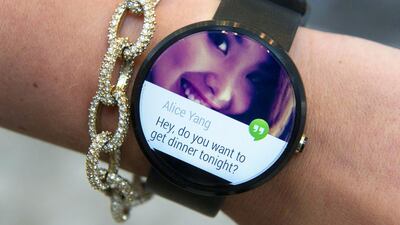Is it time? Google's latest platform may finally signal a breakthrough for smartwatches.
During last month's I/O conference of technology developers in San Francisco, Google unveiled its vision of the future. This vision seems to be for Google and its services to accompany you during every part of your daily life, which is why we saw the unveiling of Android Auto for your car, Android TV for your living room, and Android Wear for your wrists.
IDC firmly believes that connected devices are the future of technology, but we have yet to see any vendor truly crack the code in this respect, with no one successfully convincing the mass market to buy into the wearables revolution. For quite some time now, a number of vendors have actively been trying to make a name for themselves in this space, and we have already seen numerous releases from Samsung and Pebble that showcase their visions of what a smartwatch should be. However, all have met with limited success.
With this in mind, Google has drawn up what it believes to be a new winning formula for connected devices. Google's four-pronged approach, around which Andoid Wear is built, requires these devices to be voice operated, contextually aware, and capable of providing a seamless user experience. Most importantly, however, they must revolve around the consumer's smartphone. In this regard, Android Wear devices can be synched with any smartphone running its Android operating system, version 4.3 and above.
With Android Wear, Google is hoping to change perceptions in the marketplace by providing vendors with a platform to build on that has been designed specifically for wearables. The software will allow for both square and circular form factors and provide users with the ability to receive relevant information at a glance and then interact with that information either through touch or voice commands. Through these inputs, users could check their notifications, engage in calls, control their music, order food and so on.
Among the incredible statistics quoted by Google during its keynote at I/O 2014 was the revelation that Android smartphones are checked by their owners at least 100 billion times per day. That works out at a daily average of 125 times per user, a figure that Google is hoping to drastically reduce with Android Wear. However, IDC believes it would still be easier for users to perform many of the most common tasks simply by pulling their smartphones out of their pockets instead of shuffling through a series of swipes and gestures on their wrists.
During I/O 2014, Google showcased the first three devices to run the Android Wear platform - Samsung's Gear Live, LG's G Watch, and Motorola's Moto 360. The Samsung Gear Live and LG G Watch both went the route of the more traditional square screen design. Internally, the similarities continue, with both devices being powered by a 1.2 GHz processor, 512MB of RAM, a 400mAh battery and 4GB of internal storage. The devices are both available to order now.
The more interesting Moto 360 will not be available until later this year. The Moto 360 will be the first Android Wear device to ship with a round screen, and is seen by many as the best-looking smartwatch on the market. IDC believes this could be a formula that rival vendors have to emulate if they are to gain serious ground in the market.
In relation to the all-important question about battery life, there is not yet any information available for the Moto 360. However, the Samsung and LG devices will generally run for about a day before requiring a recharge. This leads us to another major hurdle that these devices must overcome - consumers are already concerned enough that their smartphones will not last the day that they carry a spare charger around with them whenever possible. The last thing they need is for this issue to be compounded by having yet another device that requires constant charging.
Despite IDC's concerns, it is important to bear in mind that Google's Android Wear platform is still very much in its infancy. These three devices merely mark the beginning of a journey that will ultimately decide whether this is the direction we should be heading with smartwatches. Apple is next in line to launch its much-rumoured iWatch later this year. The company has been under considerable pressure to unveil something truly innovative, and while it may be late to the party, if it gets it right, the time for smartwatches may finally have arrived.
Saad Elkhadem is a research analyst at IDC MEA
Follow The National's Business section on Twitter

Google takes next step into wearable technology
Google has drawn up what it believes to be a new winning formula for connected devices.
Most popular today
